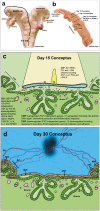Ruminant conceptus-maternal interactions: interferon-tau and beyond
- PMID: 35772752
- PMCID: PMC9246669
- DOI: 10.1093/jas/skac123
Ruminant conceptus-maternal interactions: interferon-tau and beyond
Abstract
Embryonic or fetal loss in cattle is associated with problems that occur during oocyte maturation, early embryonic development, conceptus elongation, maternal recognition of pregnancy (MRP), and/or placental attachment and implantation. Many of these problems manifest as inadequate or asynchronous communication between the developing conceptus and endometrium, resulting in pregnancy failure. This review will provide an overview of how various conceptus-endometrial paracrine signaling systems control the fate of early pregnancy in cattle and other ruminants. We begin by summarizing the actions of interferon-tau, the classic MRP signal in ruminates, and then explore how other secretory factors derived from either the conceptus or endometrium influence establishment and maintenance of pregnancy. Insight into how the endometrium responds to male vs. female conceptuses or conceptuses produced by in vitro methods will also be described. Specific focus will be placed on describing how "omic" technologies and other cutting-edge techniques have assisted with identifying novel conceptus and/or endometrial factors and their functions. Recent findings indicate that the endometrial transcriptome and histotroph are altered by conceptus sex, quality, and origin, suggesting that the endometrium is a sensor of conceptus biochemistry. Although the endometrium has a certain level of flexibility in terms of conceptus-maternal interactions, this interplay is not sufficient to retain some pregnancies. However, new information inspires us to learn more and will help develop technologies that mitigate early embryonic loss and reproductive failure in ruminants and other animals.
Keywords: bovine; embryo; endometrium; ovine; pregnancy; transcriptomics.
Plain language summary
Early pregnancy losses are common in cattle. This review describes how critical the interplay between the developing conceptus (embryo and extraembryonic membranes) and endometrium is to maintaining pregnancies in cattle and other ruminants. The discovery of interferon-tau more than 40 yr ago initiated a new field of reproductive biology focused on describing how the conceptus and endometrium communicate with one another through the secretion of paracrine factors, extracellular vesicles, and other molecules. The use of “omic” and gene editing technologies has assisted with identifying novel functions for many conceptus and endometrial secreted factors. This review provides examples of how conceptus sex, quality, and in vitro vs. in vivo development influences endometrial function. The endometrium appears to have some flexibility in its response to conceptuses, and this insight could be used to our advantage as we work towards developing schemes to rescue conceptuses that are in danger of experiencing pregnancy loss.
© The Author(s) 2022. Published by Oxford University Press on behalf of the American Society of Animal Science. All rights reserved. For permissions, please e-mail: journals.permissions@oup.com.
Figures



References
-
- Albers, R. E., Kaufman M. R., Natale B. V., Keoni C., Kulkarni-Datar K., Min S., Williams C. R., Natale D. R. C., and Brown T. L.. . 2019. Trophoblast-specific expression of hif-1α results in preeclampsia-like symptoms and fetal growth restriction. Sci. Rep. 9(1):2742. doi:10.1038/s41598-019-39426-5. - DOI - PMC - PubMed
-
- Alexandratos, N., and Bruinsma J.. . 2012. World Agriculture towards 2030/2050: The 2012 Revision ESA Working Paper No. 12-03. Rome: Food and Agriculture Organization of the United Nations.
-
- Alexopoulos, N. I., Maddox-Hyttel P., Tveden-Nyborg P., D’Cruz N. T., Tecirlioglu T. R., Cooney M. A., Schauser K., Holland M. K., and French A. J.. . 2008. Developmental disparity between in vitro-produced and somatic cell nuclear transfer bovine days 14 and 21 embryos: implications for embryonic loss. Reproduction 136:433–445. doi:10.1530/rep-07-0392. - DOI - PubMed
-
- Almeida, A. P., Ayalon N., and Bartoov B.. . 1986. Bovine endometrial epithelium ultrastructure 6 and 7 days post-breeding. Anim. Reprod. Sci. 10:293–300. doi:10.1016/0378-4320(86)90004-7. - DOI
Publication types
MeSH terms
Substances
Grants and funding
LinkOut - more resources
Full Text Sources

